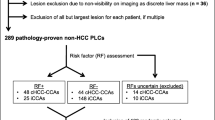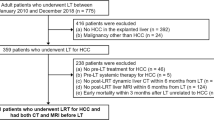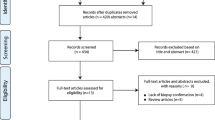Abstract
Objective
To investigate the performance of Liver Imaging Reporting and Data System (LI-RADS) v2017 treatment response algorithm for predicting hepatocellular carcinoma (HCC) viability after locoregional therapy (LRT) using the liver explant as reference.
Methods
One hundred fourteen patients with 206 HCCs who underwent liver transplantation (LT) after LRT for HCCs were included in this retrospective study. Two radiologists independently evaluated tumor viability using the LI-RADS and modified RECIST (mRECIST) with CT and MRI, respectively. The sensitivity and specificity of arterial phase hyperenhancement (APHE) and LR-TR viable criteria (any of three findings: APHE, washout, and enhancement pattern similar to pretreatment imaging) were compared using logistic regression. Receiver operating characteristics (ROC) analysis was used to compare the diagnostic performance between LI-RADS and mRECIST and between CT and MRI.
Results
The sensitivity and specificity for diagnosing viable tumor were not significantly different between APHE alone and LR-TR viable criteria on CT (p = 0.054 and p = 0.317) and MRI (p = 0.093 and p = 0.603). On CT, the area under the ROC curve (AUC) of LI-RADS was significantly higher than that of mRECIST (0.733 vs. 0.657, p < 0.001). On MRI, there was no significant difference in AUCs between LI-RADS and mRECIST (0.802 vs. 0.791, p = 0.500). Intra-individual comparison of CT and MRI showed comparable AUCs using LI-RADS (0.783 vs. 0.795, p = 0.776).
Conclusions
LI-RADS v2017 treatment response algorithm showed better diagnostic performance than mRECIST on CT. With LI-RADS, CT and MRI were comparable to diagnose tumor viability of HCC after LRT.
Key Points
• Using Liver Imaging Reporting and Data System (LI-RADS) v2017 treatment response algorithm, the viability of hepatocellular carcinoma (HCC) after locoregional therapy (LRT) can be accurately diagnosed.
• LI-RADS v2017 treatment response algorithm is superior to modified Response Evaluation Criteria in Solid Tumors for evaluating HCC viability using CT.
• Either CT or MRI can be performed to assess tumor viability after LRT using LI-RADS v2017 treatment response algorithm.




Similar content being viewed by others
Change history
23 November 2020
The original version of this article, published on 15 August 2019, unfortunately contained a mistake.
Abbreviations
- APHE:
-
Arterial phase hyperenhancement
- CT:
-
Computed tomography
- EASL:
-
European Association for the Study of the Liver
- GEE:
-
Generalized estimating equation
- HCC:
-
Hepatocellular carcinoma
- LI-RADS:
-
Liver Imaging Reporting and Data System
- LRT:
-
Locoregional therapy
- LT:
-
Liver transplantation
- mRECIST:
-
Modified Response Criteria in Solid Tumors
- MRI:
-
Magnetic resonance imaging
- PACS:
-
Picture archiving and communication system
- RFA:
-
Radiofrequency ablation
- TACE:
-
Transarterial chemoembolization
- WHO:
-
World Health Organization
References
Yao FY, Fidelman N (2016) Reassessing the boundaries of liver transplantation for hepatocellular carcinoma: where do we stand with tumor down-staging? Hepatology 63:1014–1025
Miller AB, Hoogstraten B, Staquet M, Winkler A (1981) Reporting results of cancer treatment. Cancer 47:207–214
Therasse P, Arbuck SG, Eisenhauer EA et al (2000) New guidelines to evaluate the response to treatment in solid tumors. J Natl Cancer Inst 92:205–216
Bruix J, Sherman M, Llovet JM et al (2001) Clinical management of hepatocellular carcinoma. Conclusions of the Barcelona-2000 EASL conference. European Association for the Study of the Liver. J Hepatol 35:421–430
Lencioni R, Llovet JM (2010) Modified RECIST (mRECIST) assessment for hepatocellular carcinoma. Semin Liver Dis 30:52–60
Shim JH, Lee HC, Kim SO et al (2012) Which response criteria best help predict survival of patients with hepatocellular carcinoma following chemoembolization? A validation study of old and new models. Radiology 262:708–718
Jung ES, Kim JH, Yoon EL et al (2013) Comparison of the methods for tumor response assessment in patients with hepatocellular carcinoma undergoing transarterial chemoembolization. J Hepatol 58:1181–1187
Kim HD, Shim JH, Kim GA et al (2015) Optimal methods for measuring eligibility for liver transplant in hepatocellular carcinoma patients undergoing transarterial chemoembolization. J Hepatol 62:1076–1084
Gordic S, Corcuera-Solano I, Stueck A et al (2017) Evaluation of HCC response to locoregional therapy: validation of MRI-based response criteria versus explant pathology. J Hepatol 67:1213–1221
American College of Radiology. Liver imaging reporting and data system (LI-RADS). American College of Radiology. Web site. https://www.acr.org/Clinical-Resources/Reporting-and-Data-Systems/LI-RADS/CT-MRI-LI-RADS-v2017. Accessed 1 June 2017
Kielar A, Fowler KJ, Lewis S et al (2018) Locoregional therapies for hepatocellular carcinoma and the new LI-RADS treatment response algorithm. Abdom Radiol (NY) 43:218–230
Seo N, Kim MS, Park MS et al (2019) Optimal criteria for hepatocellular carcinoma diagnosis using CT in patients undergoing liver transplantation. Eur Radiol 29:1022–1031
Luca A, Caruso S, Milazzo M et al (2010) Multidetector-row computed tomography (MDCT) for the diagnosis of hepatocellular carcinoma in cirrhotic candidates for liver transplantation: prevalence of radiological vascular patterns and histological correlation with liver explants. Eur Radiol 20:898–907
Elsayes KM, Hooker JC, Agrons MM et al (2017) 2017 version of LI-RADS for CT and MR imaging: an update. Radiographics 37:1994–2017
Edmondson HA, Steiner PE (1954) Primary carcinoma of the liver: a study of 100 cases among 48,900 necropsies. Cancer 7:462–503
Hillis SL, Berbaum KS, Metz CE (2008) Recent developments in the Dorfman-Berbaum-Metz procedure for multireader ROC study analysis. Acad Radiol 15:647–661
Landis JR, Koch GG (1977) The measurement of observer agreement for categorical data. Biometrics 33:159–174
American College of Radiology. Liver Imaging Reporting and Data System. https://www.acr.org/Clinical-Resources/Reporting-and-Data-Systems/LI-RADS. Accessed 6 May 2019
Bargellini I, Vignali C, Cioni R et al (2010) Hepatocellular carcinoma: CT for tumor response after transarterial chemoembolization in patients exceeding Milan criteria--selection parameter for liver transplantation. Radiology 255:289–300
Hunt SJ, Yu W, Weintraub J, Prince MR, Kothary N (2009) Radiologic monitoring of hepatocellular carcinoma tumor viability after transhepatic arterial chemoembolization: estimating the accuracy of contrast-enhanced cross-sectional imaging with histopathologic correlation. J Vasc Interv Radiol 20:30–38
Kloeckner R, Otto G, Biesterfeld S, Oberholzer K, Dueber C, Pitton MB (2010) MDCT versus MRI assessment of tumor response after transarterial chemoembolization for the treatment of hepatocellular carcinoma. Cardiovasc Intervent Radiol 33:532–540
Shim JH, Han S, Shin YM et al (2013) Optimal measurement modality and method for evaluation of responses to transarterial chemoembolization of hepatocellular carcinoma based on enhancement criteria. J Vasc Interv Radiol 24:316–325
Cha DI, Jang KM, Kim SH, Kang TW, Song KD (2017) Liver Imaging Reporting and Data System on CT and gadoxetic acid-enhanced MRI with diffusion-weighted imaging. Eur Radiol 27:4394–4405
Cha DI, Lee MW, Kim YK et al (2014) Assessing patients with hepatocellular carcinoma meeting the Milan criteria: is liver 3 tesla MR with gadoxetic acid necessary in addition to liver CT? J Magn Reson Imaging 39:842–852
Kakihara D, Nishie A, Harada N et al (2014) Performance of gadoxetic acid-enhanced MRI for detecting hepatocellular carcinoma in recipients of living-related-liver-transplantation: comparison with dynamic multidetector row computed tomography and angiography-assisted computed tomography. J Magn Reson Imaging 40:1112–1120
Funding
The authors state that this work has not received any funding.
Author information
Authors and Affiliations
Corresponding author
Ethics declarations
Guarantor
The scientific guarantor of this publication is Mi-Suk Park.
Conflict of interest
The authors of this manuscript declare no relationships with any companies whose products or services may be related to the subject matter of the article.
Statistics and biometry
Kyunghwa Han performed statistical analysis, who is one of the coauthors.
Informed consent
Written informed consent was waived by the Institutional Review Board.
Ethical approval
Institutional Review Board approval was obtained.
Methodology
• Retrospective
• Diagnostic or prognostic study
• Performed at one institution
Additional information
Publisher’s note
Springer Nature remains neutral with regard to jurisdictional claims in published maps and institutional affiliations.
Electronic supplementary material
ESM 1
(DOCX 19 kb)
Rights and permissions
About this article
Cite this article
Seo, N., Kim, M.S., Park, MS. et al. Evaluation of treatment response in hepatocellular carcinoma in the explanted liver with Liver Imaging Reporting and Data System version 2017. Eur Radiol 30, 261–271 (2020). https://doi.org/10.1007/s00330-019-06376-5
Received:
Revised:
Accepted:
Published:
Issue Date:
DOI: https://doi.org/10.1007/s00330-019-06376-5




